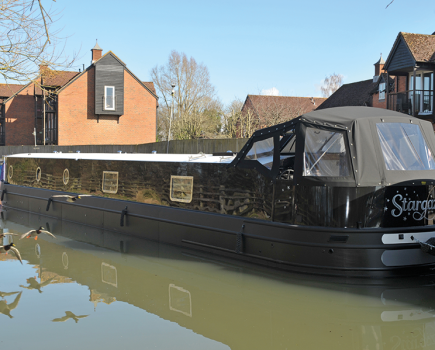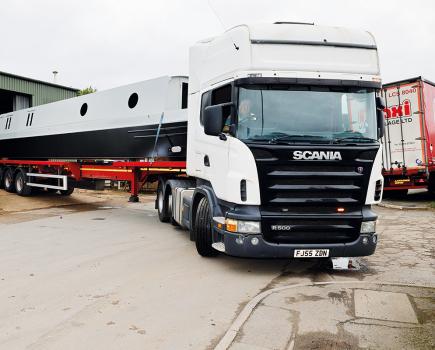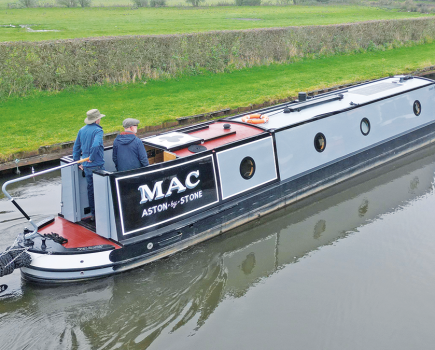Mirabilis means amazing, wondrous or remarkable, which pretty much sums up Abbi and Graham Roper’s new life on board their boat.

For some it’s a pretty big decision to sellup entirely on land to start a new life onthe water, but that’s exactly what Abbi and Graham Roper have done. Their house has gone, along with all its furniture and the vast majority of what they owned. They’ve taken the plunge and started again – afloat. If you’re going to make such a momentous move there are a few things you can do to minimise the risk. One is making sure that whoever you choose to build the boat you’re going to live on knows exactly what they’re doing and can give you what you want. Abbi and Graham chose Braidbar, which has a good reputation and a long history; the Ropers’ boat, Mirabilis, is the firm’s 150th, so they’ve pretty much seen it all. They’ve built liveaboards, holiday boats and community craft, in all sorts of lengths and taking into account all sorts of requirements. It means they know what works and what could cause problems. Abbi and Graham say Braidbar have built them the boat they wanted – but they’re confident that if they’d asked for something which wouldn’t have worked, the firm’s owners, Susan and Peter Mason, would have told them.
EXTERIOR
This 60-footer has a very striking colour scheme of mostly black, with white coach lines; actually, it’s a slightly off white called ermine – the important thing is that it’s definitely not cream. The name panels are in the same white, surrounded by a coach line of lime green. The same colour is used in the shading of the sign writing, demonstrating that sparing use of a very bright colour can look very effective. The sign-writing is by Andy Russell, undoubtedly one of the best in the business, whose skills are on full display here: Mirabilis is in an unusual font and he’s also painted a couple of things that nod towards Abbi and Graham’s Wicken beliefs – a cauldron on the gas locker lid, and a very clever pentacle on the rear slide. This ancient symbol of protection is made up of roses, combining elements of Wicken with traditional canal art. The hull has a white roof, but the aft section is scumbled with a panel of diamonds down the middle. The handrails are bright red, which helps lift the whole look. The shell is by Tyler Wilson and typically good looking. The bow is a pretty shape and there are nice details everywhere, such as scrolls in the handrails and cants and a boatman’s beam across the roof. The rear slide is extra long so, when it’s open, there’s plenty of space for crew to join the steerer. It also makes getting in and out much easier. The gas locker is in the nose and there’s a stainless steel water tank under the well deck. The well itself has a useful locker across the front that provides access to the bow thruster tube, storage and (with the addition of a cushion) comfortable seating. The stern deck has a couple of brass sockets where ‘captain’s perches’ can be slotted in. I would recommend that these seats aren’t used while travelling because they’re in the arc of the tiller, but they make a nice place to sit when moored up. This is an all-porthole boat with double-glazed units. All the trim, such as mushroom vents, is brass and in an effort to maintain the traditional lines of the boat, Abbi and Graham take their self-seeking satellite system off the roof when it’s not in use. There is one non-traditional feature up there, though – a Wi-Fi hotspot finder. This decent-sized antenna folds flat when not in use but, when it’s up, it helps find nearby hotspots and is connected to a router inside.

LAYOUT AND FIT-OUT
The couple have gone for a reverse layout. At the stern there’s the engine room with the engine under the floor. Next comes the galley which has a breakfast bar, leading into the saloon. A walk-through shower room is next, with the cabin at the bow. The fit-out uses a combination of ash and oak. Below the gunwales there’s oak-faced ply, while above there’s ash read and bead tongue and groove, set diagonally, but in a different direction at each end of the boat. So, from whichever end you enter, the diagonals slope away from you until you reach the halfway point. The ceiling is white-painted ash-faced ply, which helps to produce a bright, contemporary look. The floor is made from beautiful burnt and oiled oak planks, which should be very hard wearing as well as good looking. It’s a choice that has proved popular among Braidbar customers and it’s easy to see why.
ENGINE ROOM
The engine room contains all the boat’s technical equipment. As previously mentioned, the engine is under the floor and there’s a generator set to one side. Its cover provides a useful place to sit. On the other side, an electrical cupboard contains the inverter with the diesel boiler at the bottom. There’s the usual fuse panel and gauges, including a fuel gauge and Victron battery monitor. This room provides plenty of storage space and is also a buffer between the outdoors and the interior, somewhere convenient to take off your boots and hang coats.

GALLEY
A central doorway leads from the engine room to the galley, and that central corridor continues with units both sides. One run begins with a full height unit containing a Thetford oven and grill set at eye level, with a Panasonic combination microwave above. Beyond this there’s a white ceramic sink set into a sparkly granite worktop which has the drainer milled into it. The tap provides filtered water as well as hot and cold. Also set into the worktop is a Spinflo four-burner gas hob. Below this there’s a Bosch slimline dishwasher. Abbi and Graham say they use a programme that takes under half an hour and uses only nine litres of water – that’s almost certainly less than you’d get through in a day’s washing up. The units this side end in a pleasingly bulbous breakfast bar, which the couple chose in preference to a dinette. There’s a cupboard underneath and also a large Bosch washer drier, accessible from the saloon side. The breakfast bar has a couple of comfortable stools and Abbi and Graham say they use the area all the time; when they have guests on board, there’s even room to seat four. The other side of the galley has a set of drawers and houses a full size 240-volt fridge and a similar sized freezer under the worktop. Higher voltage appliances were chosen as the boat has a large battery bank and a generator on board; they can also be more efficient than their 12-volt equivalents. There’s also a built-in wine rack and a can cupboard under the gunwales. A run of high level cupboards provides even more storage space. Even though this is an all-porthole boat, there’s no shortage of light thanks to a Houdini hatch in the ceiling and a set of glazed side doors.

SALOON
The saloon has open shelf units down one side, either side of a chrome Lockgate Refleks diesel stove. It sits on a raised hearth and has a very attractive slate-tiled panel behind. On the other side of the boat a column radiator in grey matches the slate, underneath a set of side doors (which this time aren’t glazed). Seating is provided by a couple of comfortable captain’s chairs. At the far end of the saloon, there’s a large, deep cupboard across the boat that houses Abbi’s cookery books and some high-tech kit. Press a button on a remote control and a flat-screen TV rises up out of the unit; a separate drop-down door at the top houses an Orbit sound bar which comes forward on runners. This provides surround sound and means there’s no need for speakers set into the ceiling. What’s more, it is Bluetooth enabled, so you can play music through it from a smartphone or tablet. It’s clever stuff and Graham says the sound quality is excellent.
SHOWER ROOM
The shower room is a walkthrough, with the route through the boat going from corner to corner. There’s a large quadrant shower, lined with attractive sparkly Mermaid board. The light over the shower has an extractor fan. Between the shower and the cabin sides there are couple of cupboards with pop-off fronts; the lower one houses the calorifier (it’s good to have it next to the shower because there’s very little wait for hot water to come through), while the one above is an airing cupboard. There’s a large chrome heated towel rail under the gunwales. In the opposite corner, a unit carries a granite worktop with a smart white basin on top. The granite extends attractively down the boat, over a useful set of shelves. There’s a mirror above the basin, and a 240-volt shaver socket. The toilet is a macerating unit by Sanimarine. The holding tank is immediately behind on the other side of the bulkhead, so the length of pipe between the two can be measured in inches – something that anyone who’s struggled with yards of potentially blocked pipes will appreciate.

CABIN
The bed is in-line, and can extend to 5ft wide. As the toilet tank takes up half the space underneath, there’s long term storage in the other half. Above the bed a run of high level cupboards extends around the corner above the bed head. The main wardrobe is at the foot of the bed and provides a combination of hanging space, drawers, and shelves. On the opposite side there’s more storage in a corner unit with a mirror above and a flat-screen TV on top. The steps up to the well deck also give more space for hiding things away. There’s another grey column radiator here too. Extra light comes from a Houdini hatch. The couple made sure this wasn’t over the bed as they didn’t want to be dripped on by condensation in the night.

TECHNICAL
Mirabilis is powered by the ubiquitous Beta 43, a choice so popular that every boatyard in the country will be familiar with it. A Lewmar electric bow thruster is fitted to help with manoeuvring. The generator is also by Beta. It’s a BetaGen 7, which is essentially a smaller version of the propulsion engine, but with a very large alternator at one end. It’s cocooned in its own sound-proofed box, so runs very quietly. There’s no shortage of electrical power, with a battery bank of 800Ah. This is made up of six two-volt deep discharge cells. To make life easier, they’re fitted with an automatic topping up and degassing system. A 240-volt supply comes from a Victron Quattro 3kW inverter charger. An isolation transformer is also fitted to guard against corrosion caused by being plugged into a shoreline. It’s a more advanced system than a simple galvanic isolator. Central heating is provided by a Webasto diesel boiler. The boat also has built in gas, carbon monoxide and smoke alarms.
ON THE WATER
The combination of a Tyler Wilson shell and a Beta 43 engine means there are few surprises when on the move, and that’s a very good thing. Tyler Wilsons are some of the best handing hulls available thanks to their long swims, and Mirabilis proved no exception. We winded with ease twice during our test, both times without fuss, without using the bow thruster and, on the second occasion, in the teeth of a very stiff breeze. It’s very comfortable standing in the hatch steering. There’s a wide steerer’s step just inside the boat, and the Morse control is comfortably to hand. The instrument panel and controls for the bow thruster are also in the right place. The extra long hatch means there’s plenty of room for crew, too. And when you’ve moored up or just need to let someone off to work a lock, a hinged tiller makes their route much clearer. The look of the boat obviously struck a chord with walkers on the Macclesfield: it’s quite a while since we’ve carried out a boat test when so many people commented on what a nice boat it was.

CONCLUSION
When a boat is going to be your home you have to make good choices, and that’s exactly what Abbi and Graham have done. They’ve gone to a builder with a reputation for good quality workmanship and got a very solidly built boat. Technically, they’ve gone for tried and tested options which shouldn’t let them down. And while things such as the generator are high-spec, the systems on board are still relatively simple. It’s only when it comes to non essential extras (such as the TV that goes up and down) where they’ve allowed themselves some extravagances. The total cost of the boat was £155,000. That’s a lot of money, but is not unreasonable for a boat of this quality, especially when it’s going to be your home. It’s also explained by the addition of items such as the generator and the deep discharge batteries. It’s worth noting that when Braidbar build a spec boat (which they do every couple of years), it’s priced at around £110,000, while most boats they build are of the order of £130,000. This is a boat that should provide Abbi and Graham with a comfortable and trouble-free home for years to come – which is exactly what you need when you’re living afloat.
VERDICT
‘A well built and comfortable home on the water’.
DESIGN AND DECOR
CO/LPG Alarm: Nereus Alarms WG300-LLC nereusalarms.co.uk £400
Wi-Fi antenna: iBoost Omnidirectional marine-wifi.co.uk £270
Sound bar: Orbit M9 orbitsound.com From £199
Water filter system: Seagull purewateronline.co.uk £315
All prices are approximate and may depend on supplier and any discounts obtained
TECHNICAL SPECIFICATIONS
Braidbar Boats 60ft £155,000
Length: 60ft
Beam: 6ft 10in
Shell: Tyler Wilson tylerwilson.com 01142 781234
Style: Trad
Fit-Out: Ash and oak
Layout: Reverse
Engine: Beta Marine 43 betamarine.co.uk 01452 723492
Generator: BetaGen7 betamarine.co.uk
Batteries: Pb Batteries pbbatteries.com 0843 289 3682
Double-Glazed Portholes: channelglaze 0121 706 5777
Electrics: Victron victronenergy.com
Bow Thruster: Lewmar 8hp
BRAIDBAR BOATS
Lord Vernon’s Wharf
Lyme Road
Higher Poynton
Cheshire
SK12 1TH
01625 873471
Did you enjoy this article? Read more of our boat tests here:
The Boat Test: a small boat with big ideasBoat Test: IntegrityBoat Test: Columbus – the winner of Crick 2015
Image(s) provided by:
Archant







